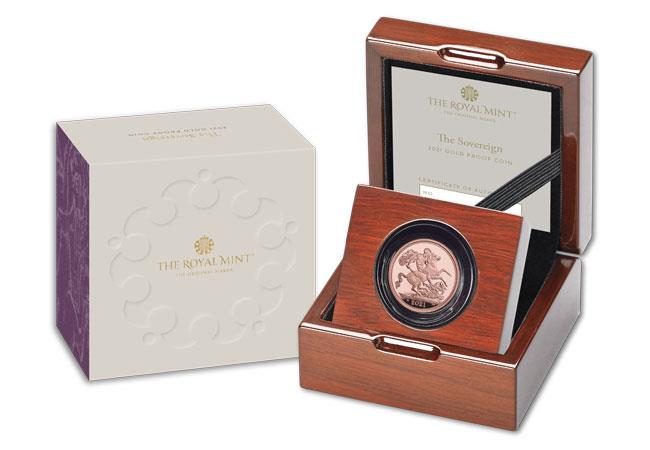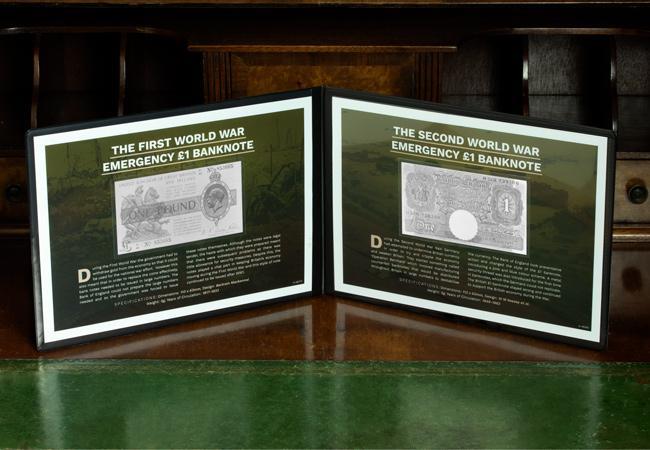Shop
Why time is ticking for you to secure the NEW 2021 Gold Proof Sovereign…
The new 2021 Gold Proof Sovereign has been released today, and it’s sure to be the Sovereign release of the decade. But you may only have days to own one. Let me tell you why…
We’re in the golden age of the Proof Sovereign. As you may know, the Proof Sovereign has become the UK’s flagship annual release that’s highly sought-after worldwide.
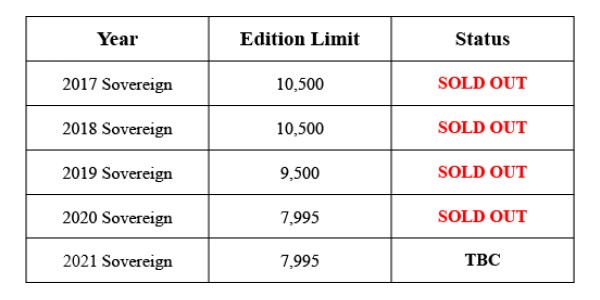
As you can see, recent UK Gold Proof Sovereigns have an undisputed track record of completely selling out. Many with a matter of weeks.
TWO special features to mark Her Majesty’s incredible reign
In 2021 we will mark the Her Majesty the Queen’s milestone 95th birthday.
To celebrate this, the Proof Sovereign features a special one-year-only unique ‘95’ privy mint mark. Sovereigns featuring privy marks are some of the most collectable Sovereigns around, so demand WILL be high.
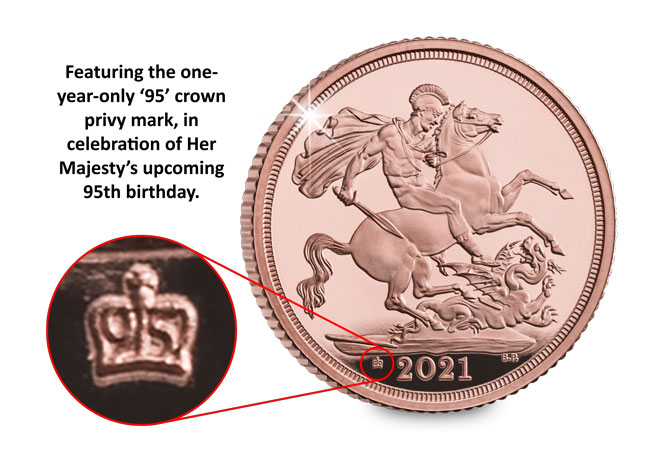
One-year-only privy marks are only applied to coins for the most significant events and anniversaries and this is certainly an important one.
But that’s not all!
Most significantly, for the first time since the Proof Sovereign was first issued as a collector’s piece in 1979, the specification has been altered and just 95 mill marks have been precisely engraved on the edge of the coin. A Sovereign would usually have 108 mills. Each one of the 95 mill marks on this coin represents a year of Her Majesty’s life, and is an exceptional tribute to her incredible life and reign.
These TWO special features mean that this Sovereign will be a collecting priority and is sure to be the most sought-after yet.
The most significant Sovereign of this decade
Queen Elizabeth IIs’ reign is arguably one of the most important and impressive in Britain’s history.
That’s because she is longest reigning head of state the UK, and in fact the world, has ever seen. 81% of the British population have been born following her coronation, so she is the only monarch that the majority of us have ever known.
Not only that, only a mere 0.9% of British people are over the age of 90 – so our Queen is part of a very elite club! This could very well be the most significant Sovereign we see this decade – it’s forever a symbol of the Queen’s longevity.
22 Carat Gold Pedigree
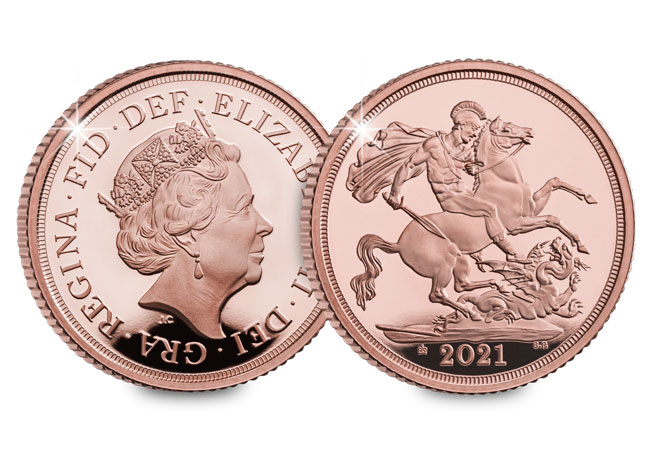
The 2021 Sovereign is minted from 22 Carat Gold and it is this historical pedigree that makes the coin so admired and sought-after around the world.
It is also one of the finest examples of British craftsmanship. The exceptional ‘proof’ finish is the result of the coin being struck up to 4 times using specially polished dies.
The time and effort required to produce the frosted relief and mirrored background of the coin is why a proof finish is considered the pinnacle of the mint-masters art – and the most sought-after by collectors.
And with an edition limit of JUST 7,995 worldwide – the SAME edition limit as last year’s Sovereign that COMPLETELY SOLD OUT in a matter of weeks – this year’s Proof Sovereign has all the elements to be the most collectable gold coin of the year, if not decade.
If you’re interested…
You can secure the 2021 Gold Proof Sovereign now, but you’ll have to act quickly. You can secure yours today for a down payment of JUST £62.50 followed by nine further interest-free instalments – the most affordable way to own the new coin.
The British banknote set to sell for up to £12,000!
Tomorrow on 28th October a Victorian £5 Banknote is set to sell at auction catalogued at up to £12,000! Now you might be wondering how an old piece of paper could be worth such an extortionate price. Well, even though it is over 150 years old, the banknote is in pristine condition – almost as if it has come straight from the Victorian Cashier who issued it himself!
The £5 Banknote, dated for the 28th December 1863 is a representation of the height of the industrial period and the advances made in Victorian Britain. In fact the design and printing technology was so advanced that the exact design was used up until 1956! You see, British Banknotes have an incredible history that is often overlooked in the collecting world…
The First UK Banknote
In 1694 King William III was at war with France, and as is often the case with warfare, the financial state of the nation was put under pressure. And so the Bank of England was established. One of its main jobs was to issue banknotes in return for deposits of gold or silver. It’s thought that the first banknote ever issued was one for £1000! But seeing as most people’s wages were less than £20 a year in those days, most people never saw a banknote.
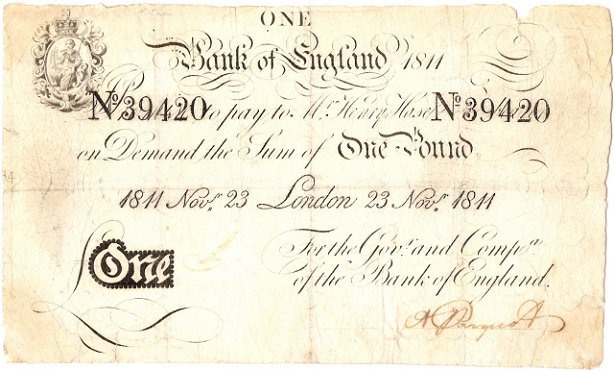
Each banknote was handwritten on bank paper addressed to the payee, and signed by a cashier to authenticate it –sort of like a modern day cheque. This is a tradition that continues today as each banknote is issued with the Chief Cashier’s signature.
“I promise to pay the barer on demand the sum of five pounds”
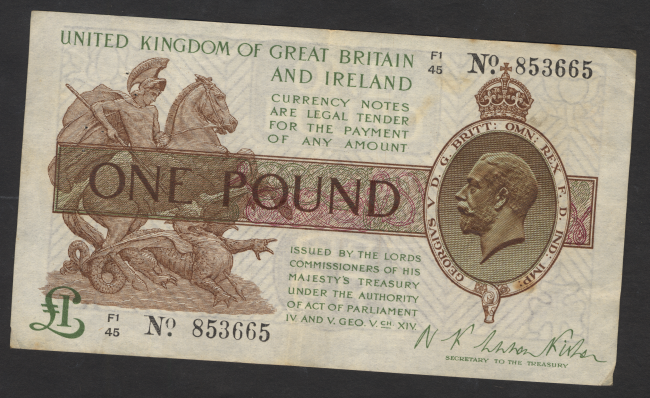
Before 1853 banknotes were completely handwritten, but the innovation of the Victorian period meant that templates for banknotes could be printed. Therefore cashiers no longer had to sign each note individually. The words “I promise to pay the bearer on demand the sum of Five pounds” were introduced to link the notes to a physical gold value. In theory, anyone could go to the bank and ask them to give them £5 worth of gold in exchange for a £5 banknote, although the meaning has changed today, the tradition remains on the banknotes.
Emergency Wartime issues
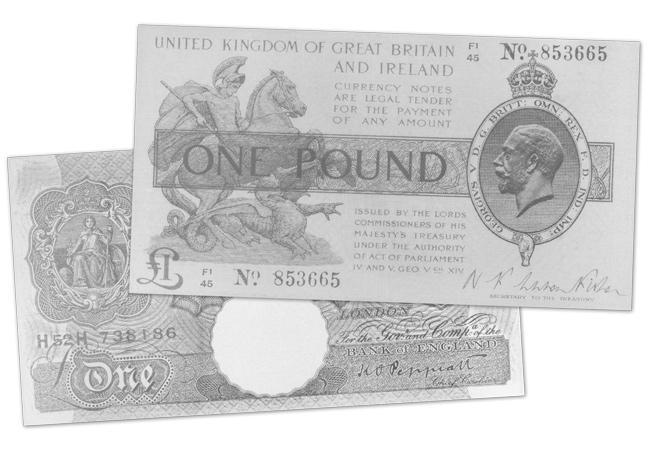
During the First World War, gold was preserved by the government and gold coins in circulation had to be withdrawn. To replace these coins, the Bank of England needed to make a large supply of £1 and 10/- notes available, but the haste at which these were produced meant that there were huge security problems. The notes were too small for cashiers to handle and they had very few anti-counterfeiting measures, but the notes themselves played a vital role in keeping the economy going.
The Second World War Nazi threat

During World War Two, the British government found out about a Nazi plot to introduced thousands of fake banknotes to destabilise British currency. However the Bank of England took emergency action and changed the colour of some of the notes for the duration of the war. The Nazi’s could not match the high levels of security features on the British banknotes and their plans failed.
Polymer banknotes
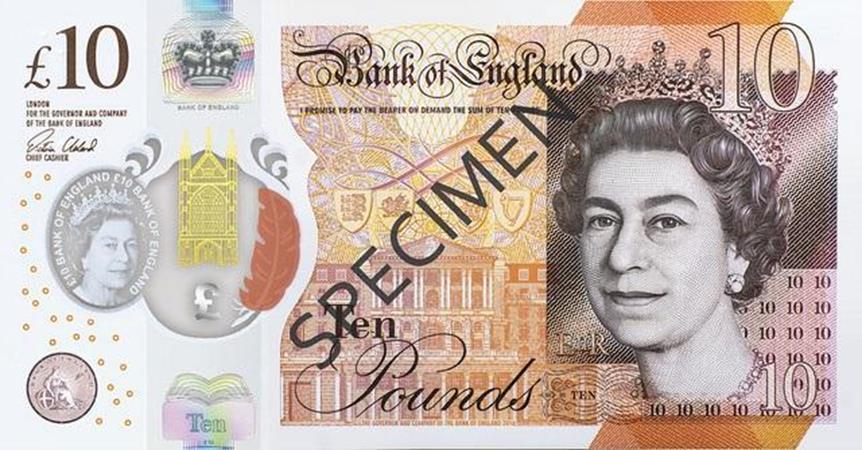
Today historic banknotes are harder and harder to get hold of, especially the ones in good condition, and those that are will often sell for thousands of pounds. Few have seen the earlier banknotes, and a small number of us remember using pre-decimal or war time banknotes in our childhoods. This is largely because the paper design which made them more susceptible to damage, so many have been lost over time. The new polymer banknotes first issued in 2016 marked a monumental change in numismatic history, bringing new technology and innovation to our pockets.
If you’re interested
Today you have the chance to own a limited edition pair of Emergency Wartime Banknote reproductions, each struck from 5g of FINE SILVER.
The Emergency Banknotes each carry a fascinating story, and your Silver versions come complete in a presentation folder telling the full story of how these banknotes helped Britain win the war.
JUST 100 of these special FINE SILVER banknotes pairs are available, so click here to order yours now, before it’s too late >>
Introducing the brand new Star Trek stamps! Boldly collect where no UK collector has collected before!
With the arrival of a new season of Star Trek: Discovery this month, and the brand new series Picard which launched earlier this year, there’s a lot for Star Trek fans to celebrate this year.
And now – in what you might say is the final frontier of stamp collecting – fans can get their hands on a brand new official Royal Mail stamp release comprising of some of the franchise’s most famous faces.

The stamps are officially released on November 13th, 2020, but you can shop our full range here and pre-order yours whilst stocks last. There are strict edition limits across our product range, so be quick if you’d like to secure yours.
Born from the mind of Gene Roddenberry, the Star Trek franchise began 54 years ago and has amassed a huge, global fanbase. It is a cultural phenomenon that’s influence spans across many generations of devoted fans, creating a global community unlike any other.
Often praised for its impact on storytelling and its influence on modern-day technology, fans and scholars alike consider Star Trek to be highly progressive in its approach to social and political issues, offering the viewer a reflective view on historic and current affairs.
This culturally significant franchise has now been celebrated for the very first time on UK stamps.
“For more than 50 years Star Trek has enthralled and inspired generations of loyal fans with extraordinary adventures and an optimistic vision of humanity’s future.
We celebrate the Star Trek Universe with stylish new stamps of its iconic characters.”
Philip Parker, Royal Mail
There are several ways to own these new issue stamps, with each stamp presentation framed and ready to display, and will be officially postmarked by Royal Mail on the day of the stamps release.
Here’s your guide to each of the products available and how you can be one of the limited number of collectors to own one of these limited edition pieces…
The Star Trek Collectors Frame
The Star Trek Collectors Frame features Royal Mail’s Collector Sheet, and only 1,995 framed editions are available worldwide.

These stamps bring together captains from six Star Trek TV series, including Captains Kirk, Picard, and Archer. Each of the stamps featured is accompanied by an Officially Licenced Philatelic Label featuring scenes from the corresponding series.
Your Collector Sheet is A4 in size and is set against a dramatic space scene – perfect for displaying in your home!
Click here to pre-order one of the 1,995 Star Trek Collectors Frames now >>>
The Star Trek Definitive Frame
Collect every Royal Mail Star Trek Stamp issue with The Star Trek Definitive Frame! This framed presentation features 12 Star Trek First Class Stamps , alongside the Movie Stamp Miniature Sheet.

These 12 brand new stamps feature every captain, alongside other famous crew members from across the six principal TV series. Each character is set against a themed backdrop inspired by the series they are from.
As well as these new issue stamps, The Star Trek Definitive Frame also includes the Movie Stamp Miniature Sheet, which showcases British stars from the Star Trek movie series.

Your frame is A4 in size and ready to display. But with only 995 available worldwide, you’ll have to be quick to snap this up for your collection.
Click here to pre-order one of the 995 Star Trek Definitive Frames now >>>
The Star Trek Ultimate Frame
While this is the first time Star Trek has featured on any UK stamp issue, it’s not the first time the franchise has been celebrated on commemorative stamps! To honour the 50th anniversary in 2016, a range of Star Trek stamps was issued in the United States.

As of last year, the stamps are no longer available to buy from the US Postal Service, but you can find a selection of these stamps within The Star Trek Ultimate Frame.

This really is the ultimate Star Trek stamp presentation, featuring every UK stamp issue alongside the no longer available US Star Trek Forever stamps.
Available in an A4 frame, there are only 295 of this very special stamp presentation available worldwide.
Click here to pre-order one of the 295 Star Trek Ultimate Frames now >>>
Remember, all framed editions of the Star Trek stamps are strictly limited. Shop the full range here to pre-order and secure yours ahead of their official release on November 13th.

